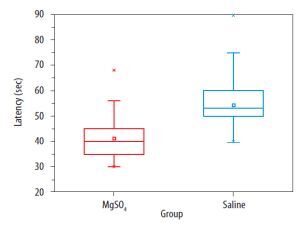ANAESTHESIOLOGY - GENERAL ANAESTHESIA / ORIGINAL ARTICLE
Influence of magnesium sulfate on the pharmacodynamic characteristics of rocuronium. A randomized clinical trial
1
University of Campinas, Campinas, Brazil
2
Department of Anesthesiology, State University of Campinas (Unicamp), Campinas, Brazil
Submission date: 2024-08-07
Final revision date: 2024-12-01
Acceptance date: 2025-01-04
Corresponding author
Vanessa Henriques Carvalho
State University of CAMPINAS (Unicamp), ANESTHESIOLOGY Department. Campinas, Brazil
State University of CAMPINAS (Unicamp), ANESTHESIOLOGY Department. Campinas, Brazil
Anaesthesiol Intensive Ther 2025;(1):11-17
KEYWORDS
TOPICS
ABSTRACT
Background:
As a multimodal anesthesia adjuvant, magnesium sulfate (MgSO4) plays an important role in the anesthetic arsenal, due to its properties and substantial synergistic effects with other drugs such as opioids, hypnotics and neuromuscular blocking drugs (NMBD). Rocuronium is a non-depolarizing NMBD used widely in general anesthesia, and its association with MgSO4 is still a concern. This study aimed to evaluate the influence of MgSO4 at a dose of 30 mg kg–1 on the pharmacodynamic characteristics of rocuronium.
Methods:
It was a double-blinded, randomized controlled trial in adult female patients scheduled for open hysterectomies with total intravenous anesthesia. Patients were allocated randomly to receive MgSO4 (30 mg kg–1) diluted in 100 mL of saline, 10 minutes before induction, or 100 mL of saline. Primary outcome: Influence of MgSO4 on latency (onset time), clinical duration (CD25%) and time to recover 90% of T4/T1 – train of four (TOF = 0.9). In total, 70 patients were enrolled, 35 per group.
Results:
The baseline characteristics were similar. A comparative analysis showed a significant difference between the groups regarding latency in seconds (lower with MgSO4) 40.00 (35–45 [30–68]) compared to saline 53.00 (50–60 [40–90]) (P < 0.001), CD25% in minutes (longer with MgSO4) 61.00 (53–70 [30–110]), saline 38.00 (35–48 [30–87 (P <0.001), and TOF = 0.9 in minutes, longer with MgSO4 98.00 (88–111 [53–176]), saline 60.00 (55–78 [44–130]) (P < 0.001). MgSO4 was found to reduce opioid consumption in the postanesthetic care unit.
Conclusions:
The strong impact of MgSO4 on the pharmacodynamics of rocuronium confirms the indispensable role of quantitative neuromuscular blockade monitoring to guide reversal.
As a multimodal anesthesia adjuvant, magnesium sulfate (MgSO4) plays an important role in the anesthetic arsenal, due to its properties and substantial synergistic effects with other drugs such as opioids, hypnotics and neuromuscular blocking drugs (NMBD). Rocuronium is a non-depolarizing NMBD used widely in general anesthesia, and its association with MgSO4 is still a concern. This study aimed to evaluate the influence of MgSO4 at a dose of 30 mg kg–1 on the pharmacodynamic characteristics of rocuronium.
Methods:
It was a double-blinded, randomized controlled trial in adult female patients scheduled for open hysterectomies with total intravenous anesthesia. Patients were allocated randomly to receive MgSO4 (30 mg kg–1) diluted in 100 mL of saline, 10 minutes before induction, or 100 mL of saline. Primary outcome: Influence of MgSO4 on latency (onset time), clinical duration (CD25%) and time to recover 90% of T4/T1 – train of four (TOF = 0.9). In total, 70 patients were enrolled, 35 per group.
Results:
The baseline characteristics were similar. A comparative analysis showed a significant difference between the groups regarding latency in seconds (lower with MgSO4) 40.00 (35–45 [30–68]) compared to saline 53.00 (50–60 [40–90]) (P < 0.001), CD25% in minutes (longer with MgSO4) 61.00 (53–70 [30–110]), saline 38.00 (35–48 [30–87 (P <0.001), and TOF = 0.9 in minutes, longer with MgSO4 98.00 (88–111 [53–176]), saline 60.00 (55–78 [44–130]) (P < 0.001). MgSO4 was found to reduce opioid consumption in the postanesthetic care unit.
Conclusions:
The strong impact of MgSO4 on the pharmacodynamics of rocuronium confirms the indispensable role of quantitative neuromuscular blockade monitoring to guide reversal.
Share
RELATED ARTICLE
We process personal data collected when visiting the website. The function of obtaining information about users and their behavior is carried out by voluntarily entered information in forms and saving cookies in end devices. Data, including cookies, are used to provide services, improve the user experience and to analyze the traffic in accordance with the Privacy policy. Data are also collected and processed by Google Analytics tool (more).
You can change cookies settings in your browser. Restricted use of cookies in the browser configuration may affect some functionalities of the website.
You can change cookies settings in your browser. Restricted use of cookies in the browser configuration may affect some functionalities of the website.



